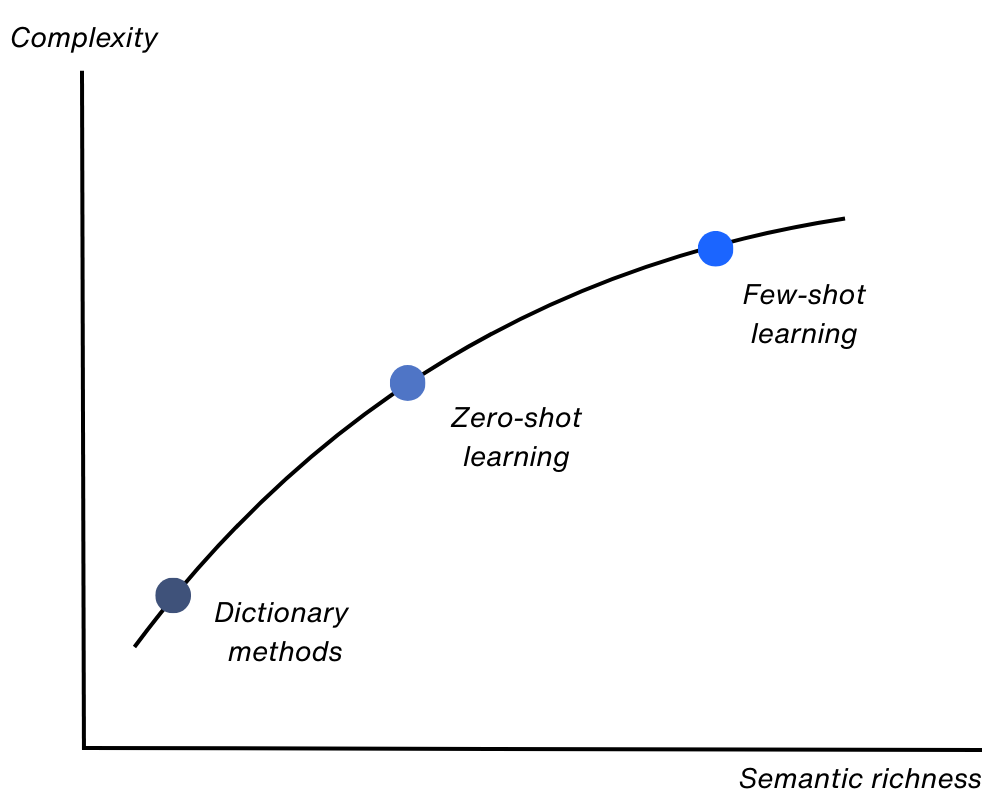We will explore three methods to generate text-based variables, ranging from simple dictionary approaches to more complex, fine-tuned few-shot learning models using pre-trained LLMs.

All examples in this post are implemented using FewShotX, a Python package
for dictionary scoring, zero-shot, and few-shot learning in text classification.
Explore the documentation and tutorials for hands-on notebooks.
1. Dictionary Methods
Dictionary methods have been widely used in economics to transform textual data into quantitative indicators. A notable example is the Economic Policy Uncertainty (EPU) index developed by Baker, Bloom, and Davis (2016), where the frequency of specific terms in newspaper articles is used to capture policy-related uncertainty over time.
These methods remain popular due to their transparency and simplicity, and continue to appear in high-impact economic research such as:
-
Ehrmann & Talmi (2020). Starting from a blank page? Semantic similarity in central bank communication and market volatility. Journal of Monetary Economics.
-
Rice & Zorn (2021). Corpus-based dictionaries for sentiment analysis of specialized vocabularies. Political Science Research and Methods.
-
Parle (2022). The financial market impact of ECB monetary policy press conferences—a text-based approach. European Journal of Political Economy.
🧰 Example: EPU-style Dictionary Scoring
from FewShotX import DictionaryScorer
# Define an EPU-style dictionary
epu_dict = {
"uncertainty": ["uncertainty", "uncertain"],
"economic": ["economic", "economy"],
"policy": ["congress", "deficit", "federal reserve", "legislation", "regulation", "white house"]
}
# Initialize scorer
scorer = DictionaryScorer(dictionaries=epu_dict, model_name="en_core_web_sm")
# Apply scoring to a dataframe of headlines/articles
df_dict = scorer.score_df(df_corpus, text_col="headline")
df_dict.head()
This example scores each text based on the presence of terms related to uncertainty, economics, and policy. You can extend this by:
- Weighting the categories
- Creating composite indices (e.g., requiring all three categories to appear)
- Normalizing by total word count or news volume
2. Zero-Shot Learning
Zero-shot learning (ZSL) enables document classification without any labeled training data. Instead of relying on predefined word lists or trained classifiers, ZSL leverages large pre-trained language models (LLMs) to evaluate the semantic similarity between a document and a set of label descriptions.
A common use case is identifying whether a piece of text (e.g., a news article) relates to a specific economic concept, such as “finance” or “inflation”, even if the system has never seen labeled examples of those concepts before.
The classification process can be summarized as:
- Given a query document $ q $, and a set of candidate labels $ \mathcal{L} $,
- Encode both the query and labels into a shared embedding space,
- Select the label $ \ell \in \mathcal{L} $ that is most semantically similar to the query.
The predicted label $ \hat{\ell} $ is obtained by: $$ \hat{\ell}_{\text{ZSL}} = \arg \underset{\ell \in \mathcal{L}}{\max} \quad \cos \left( \mathbf{E}(q), \mathbf{E}(\ell) \right) $$
🧪 Code Example
from FewShotX import Embeddings, ZeroShotLearner
# Generate embeddings
embedding_model = Embeddings(model_name='all-MiniLM-L6-v2')
df_embed = embedding_model.embed_df(df_corpus, text_col='headline')
# Define your target label
labels = ["economic policy uncertainty"]
# Instantiate the learner
zs = ZeroShotLearner(embedding_model.model, similarity='cosine')
# Score similarity between texts and label
df_scored = zs.score_df(
df=df_embed.copy(),
text_embedding_cols=[f"emb_{i}" for i in range(embedding_model.embedding_dim)],
labels=labels,
label_names=["is_epu"]
)
df_scored.head()
This approach is especially useful when:
- Labels are abstract (e.g., “risk”, “policy uncertainty”)
- You lack labeled data
- You want to prototype classification tasks quickly using LLMs
Zero-shot learning builds on the generalization power of transformer-based encoders like BERT, RoBERTa, or SentenceTransformers. It’s ideal for early exploration before moving to supervised or few-shot approaches.
3. Few-Shot Learning
Few-shot learning (FSL) bridges the gap between traditional supervised learning and zero-shot approaches by leveraging just a few labeled examples to make accurate predictions on unseen data. This is particularly valuable when building text-based indicators in low-resource or specialized domains, where labeled data is scarce or costly to obtain.
Examples include:
- Classifying nuanced monetary policy announcements or economic sanctions.
- Interpreting domain-specific texts, such as clinical reports or political news.
- Detecting emerging patterns in fraud or evolving hate speech variants.
Goal: to learn a mapping from limited support examples to labels that generalizes effectively to new, unseen queries, without relying on large annotated datasets.
🔧 Method Overview
FewShotX implements a two-stage pipeline:
- Training
A linear model with L2 regularization is trained on the support set (labeled examples). The optimization objective balances prediction error and regularization to prevent overfitting:
$$ \mathbf{W}^{\star} = \arg \min_{\mathbf{W}} \left( | \mathbf{X}^\top \mathbf{W} - \mathbf{Y} |^2 + \lambda | \mathbf{W} - \mathbb{I} |^2 \right) $$
- Prediction
New documents (query set) are classified by projecting their embeddings using the learned mapping $\mathbf{W}^{\star}$, and selecting the label that maximizes cosine similarity:
$$ \hat{\ell}_{\text{FSL}} = \arg \underset{\ell \in \mathcal{L}}{\max} \quad \cos \left( \mathbf{E}(q) \mathbf{W}^{\star}, \mathbf{E}(\ell) \mathbf{W}^{\star} \right) $$
🧪 Code Example
from FewShotX import Embeddings, FewShotLearner
# Instantiate the Embeddings class
embedding_model = Embeddings(model_name='all-MiniLM-L6-v2')
# Train our learner with the support set
learner = FewShotLearner(
support_set,
text_col='text',
label_col='label',
embedding_model=embedding_model
)
learner.fit(val_split=0.2, lam=0.1, lr=0.1, epochs=20, early_stop=5, verbose=True)
# Compute predictions on the query set
predictions, acc = learner.predict(query_set, k=3, return_accuracy=True)
predictions
🧠 Notes
- This method is ideal for applications where labeled data is scarce.
- Overfitting is common with few examples, so tuning
lambda,learning rate, andearly stoppingis critical. - Supports any encoder (e.g. SBERT, OpenAI models, etc.) and can be extended to regression or ranking tasks.
Beyond These Methods
While dictionary, zero-shot, and few-shot learning provide scalable ways to turn text into data, other complementary approaches are also common in empirical research:
- Topic Modeling (e.g., LDA): Unsupervised methods for identifying latent themes across large corpora (Blei et al., 2003). For example, Mueller & Rauh (2022) use dynamic LDA to extract 15 evolving news topics that help forecast global armed conflict.
All examples in this post are implemented using FewShotX, a Python package
for dictionary scoring, zero-shot, and few-shot learning in text classification.
Explore the documentation and tutorials for hands-on notebooks.